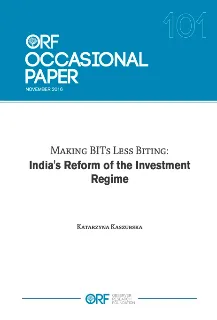Introduction
After a more than four-year long review of its bilateral investments treaties (BITs), India's new Model BIT was approved by Union Cabinet in December 2015
The traditional international investment regime, established over 50 years ago, has recently become the subject of growing criticism from many quarters. According to the UN Conference on Trade and Development (UNCTAD), at least 60 countries are currently reforming or have already 1 revised their model international investment agreements (IIAs)1. India is no exception. Following its first defeat in investment arbitration (the White Industries case2) and the flood of claims brought against it by foreign investors in the last few years, the government decided to rethink its existing investment obligations. After a more than four-year long review of its bilateral investments treaties (BITs), India’s new Model BIT was approved by the Union Cabinet in December 2015. It is intended to serve as the basis for India’s negotiations of future investment agreements as well as re-negotiations of existing ones.
Following an introductory section on the historical rise of BITs, the second part of the paper discusses India's approach to IIAs, including the investment arbitration disputes involving India. e subsequent three sections provide an analysis of the recently approved Model BIT from three dierent perspectives: i) the way it addresses the most controversial aspect of the existing investment regime, i.e.,the investor-State arbitration system; ii) its impact on India's ongoing negotiations of IIAs and FTAs with investment chapters with other countries, by comparing the Model text with the investment treaty practice of India's major trading partners; and iii) its eect on India's growing outward FDI ow. Finally, the paper concludes by encouraging a reform of the investment system at the multilateral level.
Rise of BITs
BITs are agreements signed between two countries in order to provide for reciprocal protection and promotion of investments in their territories. e concept of special rules to protect foreign business dates back to the times of Ancient Greece and the Roman Empire. It was later developed to take a form of diplomatic protection, which a home country would extend over its citizens abroad, based on the principles of customary international law. During the colonial period there was no real need for a special regime for investments abroad, as they were primarily shielded by the military and political inuence of the imperial powers. Following the dissolution of the colonial empires, the capital-exporting nations advocated the creation of a legal system protecting their investors abroad. e expansion of the modern type of treaty-based international investment law took place in the post-colonial era, in response to the nationalisation of foreign investment by the newly independent countries, as well as the large-scale expropriation of private property which took place in the Soviet Union. e rst BIT was signed between Germany and Pakistan in 1959.
By concluding an IIA, a country commits itself to guarantee specic standards of treatment to foreign investors in its territory. Traditionally, these included substantive obligations to provide foreign businesses with national treatment, non-discrimination, physical security, fair and equitable treatment, and liberal nancial transfer procedures. Finally, rearming host States' right to expropriate investments, the treaties established that any taking of property must be conducted in the public interest, follow due process and entail payment of prompt and eective compensation based on market value.
The most important procedural evolution granted investors the right to directly challenge host States before international arbitration tribunals. e Investor State Dispute Settlement (ISDS) provision was, for the rst time, included in the BIT signed by the Netherlands with its former colony, Indonesia, in 1968. It was intended to provide investors with a neutral forum to raise their grievances. It stemmed from the assumption that domestic judicial systems in developing host countries would not guarantee an independent, fair and reliable forum to adjudicate upon the complaints brought by foreigners. ISDS has gradually become a standard clause in the majority of investment treaties, whose number accelerated rapidly in the 1990s. Table 1 presents the expansion of IIAs and trade agreements with investment chapters. In 2015, there were 3,304 concluded IIAs.
Read the full report here.
The views expressed above belong to the author(s). ORF research and analyses now available on Telegram! Click here to access our curated content — blogs, longforms and interviews.

 PDF Download
PDF Download



 PREV
PREV


